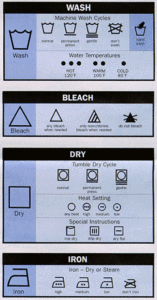Recent Developments
- Housing and House Furnishings
. . . . . Barriers to Homeowners for Minorities and Immigrants - Apparel and Textiles
. . . . . New Care Label Symbols
Housing and House Furnishings
Barriers to Homeowners for Minorities and Immigrants
New research sponsored by the U.S. Department of Housing and Urban Development and Fannie Mae has found that minorities and immigrants are likely to face little-understood barriers to homeownership. The March 1997 issue of Cityscape presents what may be the first ethnographic studies on the social and cultural forces that shape the home-purchase decisions of minority and immigrant households. (A copy of this issue of Cityscape can be found at http://www.huduser.org/ or you can purchase a copy for $5.00 from HUD USER).
Ratner summarizes the major constraints facing minorities and immigrants in pursuing homeownership:
- A lack of appropriate, affordable housing is an underlying problem that cannot be countered by making financing criteria more lenient when housing prices are truly out of reach.
- Limitations of existing finance tools include the rigid standardization in national underwriting criteria that prevent lenders from applying their knowledge about local markets and the lack of finance mechanisms for homes in need of rehabilitation.
- Cultural gaps, biases, and misunderstandings can inhibit the home buying process by distancing potential home buyers form real estate agents and lenders.
- Lack of home-purchasing knowledge and credit judgment is also a common problem for immigrants and minorities.
Despite such barriers, the immigrants and minorities in the four studies are often able to attain homeownership by looking beyond the conventional mortgage finance system.
Researcher Kate Porter Young describes the ways African Americans and low-income whites in two rural communities on the coast of South Carolina have traditionally become homeowners. Instead of financing their homes through mortgage lending, they often build on large plots of family-owned land, with labor and materials donated by family and friends or they buy a manufactured home.
Among African Americans in Syracuse, New York, a city with a relatively affordable housing market, Susan Hamilton and Stephen J.H. Cogswell found that only one-quarter of African Americans are homeowners. More than one-half of the surveyed homeowners had purchased a house at auction or through other nontraditional methods.
Susan A. Cheney and Charles C. Cheney show how differing economic and cultural backgrounds influence the home buying patterns of two immigrant groups — those from India and those from Spanish-speaking countries — in the expensive housing market of Montgomery County, Maryland. The researchers found that Indian families were using resources from their relatives in India to finance home purchases, while Hispanic families were sending funds back to their countries of origin. However, both Indians and Hispanics were unfamiliar with the credit transactions so pervasive in the U.S. economy. Hispanics particularly had trouble documenting their incomes and credit histories.
Stephen Johnston, Morisna Katimin, and William Milczarski studied immigrants from South Korea and the Dominican Republic in Queens, New York, another expensive housing market.
Contributed by: Dr. Sarah D. Kirby, Housing Specialist.
Apparel and Textiles
New Care Label Symbols
A New Wrinkle . . .
If you’ll pardon the pitiful pun–there is a new wrinkle these days in the laundering and clothing care arena. Beginning July 1, l997, manufacturers may use care labels with care symbols to specify safe cleaning methods, rather than written instructions. These symbols will become standard in countries participating in NAFTA, the North American Free Trade Agreement. For the first year, labels will include both words and symbols.
You may be seeing the new care symbols on apparel labels in retail stores now. As the symbols are implemented, laundering instructions will include four symbols; washing, bleaching, drying and ironing. Drycleaning instructions will include one symbol. The chart below, by The Clorox Company, illustrates examples of the new care symbols.

Are the dots a dilemma? Just remember, the more dots, the higher the temperature.
What about the lines? The more lines, the gentler the treatment needed.
Source: The Clorox Company
Submitted by: Judieth E. Mock and Ellen T. Miller, Apparel and Textiles Specialists.
Back to table of contents -> https://www.theforumjournal.org/2017/09/04/summer-1997-vol-2-no-3/
